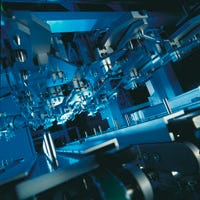Robotics, automation and assembly at the Fakuma show
Hekuma's new system is said to help processors reduce mold-open time by up to 20%.
September 29, 2008
|
The Fakuma trade show in Friedrichshafen, Germany in mid-October (www.fakuma-messe.de) is in its essence an injection molding show. As a result, attendees (MPW among them) will expect to see exhibited any number of advanced automation and assembly equipment to assist with parts' assembly, finishing or simply removal from a primary processing machine.
We'll report later on what we see there. For now, a brief preview of a few innovations expected at the show must suffice. The first, from robot manufacturer Hekuma (Eching, Germany; www.hekuma.com), will be the introduction of its Heku 3 high-speed robot. As the successor to the Heku 2, all three servo motion parameters - acceleration, constant velocity and deceleration - have been substantially increased in the new robot in order to significantly reduce part removal cycle times, says the manufacturer. Based upon initial injection molding applications, 'mold open' time has been reduced approximately 20% with these higher transfer speeds. End-of-arm-tooling weighing up to 150 kg (330 lb) can be accommodated with the new robot. The Heku 3 provides average accelerations of more than 6 g and transfer speeds up to 7 m/s (23 fps), independent of EOAT weight.
Among applications on display at Hekuma will be automotive housing components, molded medical parts and components produced under cleanroom conditions, in-mold labeled (IML) packaging produced by both injection molding and thermoforming, as well as thermoformed blister packaging with integrated RFID transponders.
Another robotics/automation supplier, Waldorf Technik (Engen, Germany; www.waldorf-technik.de), thinks it has the answer to processors' worries when involved in in-mold labeling (IML) projects. Typically, the automation used in IML applications is suitable for a single package shape/design. Change the shape, and new automation is required. But Waldorf Tehnik claims its new highflex system can be used for IML with practically all label and package geometries. Only the final format components (gripper elements and such) must be altered, along with the corresponding process parameters of the individual movements. Waldorf says it can deliver these to molders in 12-15 weeks versus what it claims are 26-34 week delivery times at present for conventional product-dependant robot systems.
Plastics welding equipment supplier Herrmann Ultrasonics (Karlsbad, Germany; www.herrmannultraschall.com) is keeping some details reserved until the event but says Fakuma will be the unveiling of its new HiQ evolution welding system, which it says will offer “a significant reduction" in auxiliary process time between cycles. EOATs can be automatically changed as part of a new start-up operation. Processors can save up to 80% on compressed air with the new welding units, reports the firm. The new units also already fulfill the EU user safety requirements of the Directive that takes effect in late 2009.
Also at that show, Plasmatreat (Steinhagen, Germany; www.plasmatreat.de) plans to up the ante of its plasma treatment system, OpenAir. Unlike most plasma systems, Openair systems operate at atmospheric pressure, with no need for a vacuum or closed container. In the next step to a project it showed at last October's K show, Plasmatreat will share a stand with Ceracon to demonstrate a pilot production cell in which PP (polypropylene) and polyurethane foam are combined in a single part using Ceracon's foaming technology and Plasmatreta's Openair process to ensure adhesion of the formed-in-place foamed gaskets. The plasma treatment for this project was done outside of the mold at the K show; this time, MPW understands that treatment will be done in-mold.
You May Also Like



